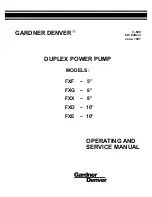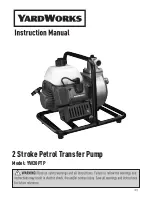
© Copyright 2014 Zoeller
®
Co. All rights reserved.
6
1. If the pump is used as part of a permanent installation,
secure to a rigid foundation with appropriate fasteners.
2. Locate the pump as close to the water source
as possible, keeping the suction pipe as short as
conditions permit.
3. Avoid dips or pockets in offset piping or air will
accumulate at high points which will make priming
difficult.
4. The suction pipe should slope upward to the pump
inlet. A horizontal suction line must have a gradual
rise to the pump.
5. On suction lift installations, a foot valve located in the
water or a check valve located as close to the water
as possible will reduce priming time of the pump and
help maintain prime. A strainer that will pass 3/32”
to 1/8” max. diameter particles must be used on the
suction line to filter out dirt and debris.
6. A priming tee installed in the pump discharge port
allows water to be poured into the pump case and
suction piping, which is required for priming on suction
lift installations.
7. Install a gate valve and union in the suction and
discharge lines. For removal of the pump for service,
close the gate valve and disconnect the union.
CAUTION
Do not use a globe valve or other
restricting type of valve at the discharge. This will
seriously restrict the capacity of the pump.
8. Pressure Gauges - Properly sized vacuum or pressure
gauges can be installed in both the suction and
discharge pipe. The gauges will enable observation
of the pump's performance as well as detecting
cavitation, vapor binding or other unstable operation.
CAUTION
Use only components that are rated higher
than shut-off pressure of the system. Do not exceed the
pump's maximum case pressure of 100 PSI.
A pressure relief valve of adequate
capacity must be installed on any installation where the
pump pressure can exceed the pressure tank's maximum
working pressure or on systems where the discharge line
can be shut-off or obstructed. Not providing a relief valve
can cause extreme over pressure which could result in
personal injury and/or property damage.
IL0415
Pressure Gauge
Rigid
Foundation
Priming Plug
Level
Pipe
Support
Discharge
Suction Pipe Installed with
Gradual Rise to Pump Inlet
Figure 4
ELECTRICAL
Ground motor before connecting to
electrical power supply:
Connect the motor frame to equipment
grounding conductor by using green
screw. Do not connect green ground
wire to any of the motor leads.
Do not ground to a gas supply line.
Turn off power to motor before working
on electrical connections.
Supply voltage must be within ±10% of
nameplate voltage when the pump is
running. If in doubt consult a licensed
electrician.
Use wire size specified in wiring Chart D. If wiring diagram
on motor model plate differs from diagram shown in
Figures 5 & 6, follow diagram on motor.
SEE CAUTIONS AND WARNINGS ON
PAGE 1.
WIRING
1. Motor voltages will vary depending upon the motor
horsepower and phase. Refer to the motor nameplate
and the Motor Data Chart (Chart B) for voltage and
electrical data.
2. To change voltage, remove the rear access cover, which
is held in place with two (2) screws. For proper electrical
connection, refer to the connection diagram located on
the motor nameplate or Figure 5 above.
Replace rear access cover before
starting or operating pump.
Failure to do so can result in
personal injury.
MOTOR PROTECTION
1. All single phase motors have built-in thermal protection
for all voltages. The overload protects the motor against
burnout from overload of low voltage, high voltage and
other causes. The device is automatic and resets itself
once the temperature has dropped to a safe point.
Frequent tripping of the device indicates trouble in the
motor or power lines and immediate attention is needed.
2. All motors must be equipped with a correctly protected
circuit and a disconnect switch to provide protection.
Consult local or national electric codes for proper fuse
protection based on motor data chart (see Chart B).
Hazardous
voltage. Can
shock, burn or
cause death.
Failure to follow
warnings can
cause fatal or
severe shock
hazard or
equipment failure.
L1
L2
A
B
L1
L2
A
B
IL0180
YELLOW
115 VOLT
SINGLE PHASE
LINE
230 VOLT
SINGLE PHASE
LINE
WHITE
GRAY
RED
TAN
YELLOW
WHITE
GRAY
RED
TAN
Figure 5 - Wiring Diagram for Single Phase 1/3-2 HP


























